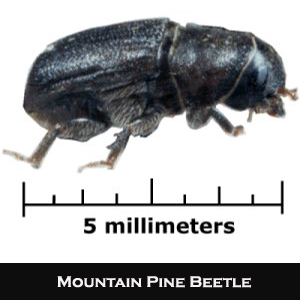With increases in global temperature and milder winters, the Mountain Pine Beetle is turning vasts tracks of forest into a wasteland.
The British Columbia Ministry for Environment says it is “currently experiencing an epidemic throughout the range of lodge pole pine forests in the province. This epidemic is the result of a number of factors including natural beetle population cycles, continuous mild winters, and an abundance of uniformly mature pine forest stands.”
In a Ministry of Forests report released in September 2007, the mountain pine beetle is projected to kill more than three-quarters of British Columbia’s marketable pine forests within the next eight years.
“If the infestation continues to behave as it has over the past eight years, it is projected that 78 per cent of the pine volume or 23 per cent of the total volume on the provincial timber harvesting land base will killed by 2015,” the report said.
British Columbia’s total timber-harvesting land base is 4.6 billion cubic metres. The report said the mountain pine beetle epidemic will kill more than one billion cubic metres of pine by 2015.
The insect, Dendroctonus ponderosae, is a species of bark beetle native to the forests of western North America from Mexico to central British Columbia.

Mountain pine beetles inhabit pines, particularly the Ponderosa Pine, Lodgepole Pine, Scots Pine and Limber Pine. The bristlecone pines and pinyon pines are less commonly attacked. During early stages of an outbreak, attacks are limited largely to trees under stress from injury, poor site conditions, fire damage, overcrowding, root disease or old age. As beetle populations increase, the beetles attack most large trees in the outbreak area.
The beetles kill the trees by boring through the bark into the phloem layer on which they feed and in which eggs are laid. Pioneer female beetles initiate attacks, and produce pheromones which attract other beetles and results in mass attack. The trees respond to attack by increasing their resin output in order to discourage or kill the beetles, but the beetles carry blue stain fungi which, if established, will block the tree resin response. Over time (usually within 2 weeks of attack), the trees are overwhelmed as the phloem layer is damaged enough to cut off the flow of water and nutrients. In the end, the trees starve to death, and the damage can be easily seen even from the air in the form of reddened needles. Entire groves of trees after an outbreak will appear reddish for this reason.
The beetle is responsible for massive damage to lodgepole pine forests in Canada, where a reduction in the severity of winters has allowed the population to explode.
Higher average temperatures would assist the beetle to increase in population and range. However it was unusually cold in northern Colorado through the 2009/10 winter, and some people with mountain properties thought their pine beetle problems were over. Unfortunately, cold winter weather can kill off the insects, but it has to be extreme: 30 below zero for five days or more.
“In winter months, pine beetles are in the larval stage, snugly settled in beneath the bark. The larvae actually produce antifreeze in their bodies, and as it gets colder, they produce more of the chemical. That’s why they’re well protected from the cold. However, sudden cold snaps in fall or late spring can do them in, because the antifreeze protection is weaker at those times.”(1)
The Colorado State Forest Service has compiled a list of products used for pine beetle prevention, with pros and cons about each. The list can be found here.
Reference 1. Cherry Sokoloski, 2010, Winter of 2009-10 didn’t phase pesky pine beetle, North Forty News http://www.northfortynews.com/News/201005photo_03_pineBeetleWeather.htm
|
Other Species Impacted Upon by Climate Change
Quiver Tree |
